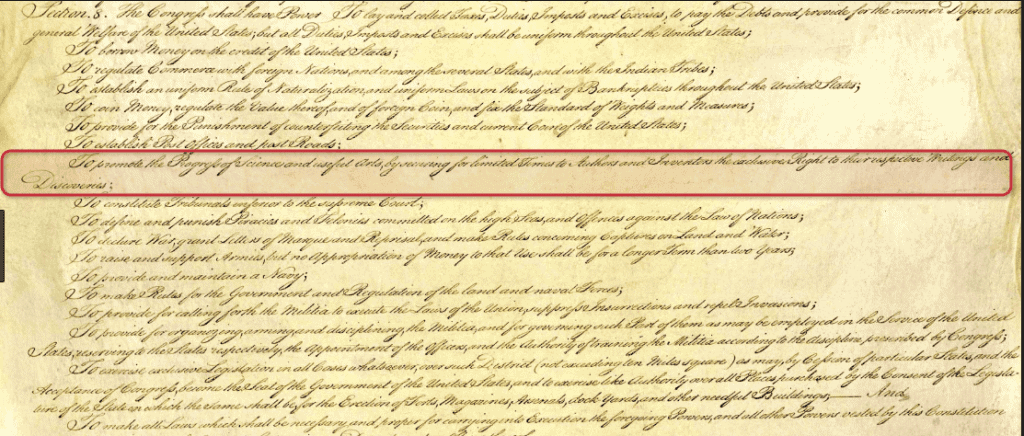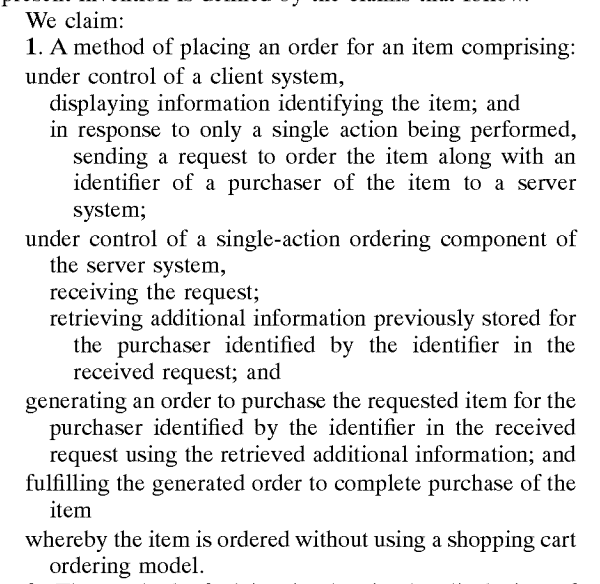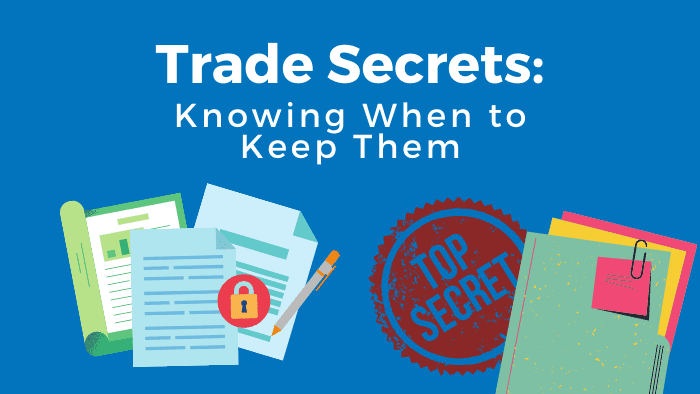As a business owner, you know what makes your company better.
It is that thing that makes you more desirable to customers, even if very subtle, that is your trade secret.
It’s your how or your ways of doing business that make up your trade secret portfolio. And, as you’ll read below, while it is important to identify what information may be trade secret, it is even more important to know when to hold the information within your company, or instead seek patent protection.
Knowing where you sit in the competitive framework is also an important part of it, and it cannot be overlooked. It’s so true that you’ve got to keep your friends close and your enemies closer.

Understanding your competition is a vital part of managing your trade secret portfolio AND running a successful business…
…what’s interesting though (and perhaps surprising) is it’s not so much what you know about the other guy…but what others don’t know about you that gives you that edge…
And that’s where the concept of Trade Secrets enters the conversation.
I like to call Trade Secrets, “Pre-Patents” sometimes. Because, as you’ll read below, that’s exactly what they are! Inventions, Ideas, Solutions that you likely could seek patent protection for, but due to cost, risk of infringement, timing, detectability – you have decided to wait.
Most people think that trade secrets have to be a BIG bombshell secret of earth-shattering magnitude, and it’s just not true.
Trade Secrets can be quite trivial, and can simply be the way you do things, the information/data you have, your culture, innovation, ideas, methods, processes, know-how, and secret sauce.
I love intellectual property! I mean, that’s probably why I started my law firm, “Bold Patents”, right? Now…we’re a law firm – and likely a VERY different company from yours. But we are a business too – just think, we deliver legal services for sale!
So yeah, you bet we have trade secrets. We have ways in which we communicate to our clients, deliver our legal opinions, work together virtually, etc. So if a law firm has trade secrets, you can bet your company has trade secrets too.

As a quick aside, I care so darned much about this stuff that I wrote a book on it for other lawyers out there that either, don’t realize their law firm has IP or want to learn more about how to protect their firm’s IP.
I am writing this article as a trade secret protection guide of sorts. To do that effectively, I need to nail down the BIG picture, to make sure you are not confusing the 4 major areas of intellectual property (IP).
The Big Four Areas of Intellectual Property…
There are four major areas of intellectual property:
- Patents
- Trademarks
- Copyrights
- Trade Secrets
Trade Secrets are unlike the other three areas of Intellectual Property in that there is no registration or certificate that the government (or anyone) bestows upon the owner.
The rights are actually to get legal damages against someone who takes trade secrets from you, a crime known as misappropriation.
So, if you follow the rules, you have a legally enforceable right to protect your trade secret.

Trade Secret Law is both State and Federal law. Most states have adopted the Uniform Trade Secrets Act. This is also called the federal trade secrets act.
State courts have (since 1985-ish) heard complaints from plaintiffs seeking damages, but they have been frustrated by recent companies that are increasingly becoming national (and even international).
Thus, as of 2016, the Federal Defend Trade Secrets Act was passed, providing a mechanism to bring a would-be-infringer into federal court based on the subject matter alone.
The UTSA and the DTSA provide a great framework for defining when information qualifies as a “Trade Secret” and when trade secret information has been misappropriated:
Do You Even Have a Trade Secret?
Ever wonder what qualifies as a trade secret? You’ve got a trade secret if the following three things are true about your company’s information:
- Not readily known in the public
- Derives independent economic value
- Reasonable efforts made to keep secret
Some of our clients get hung up on the first bullet point about not being known in the public. Note that this doesn’t mean that nobody else knows. It just means that the average person in the industry doesn’t know.
I like to rephrase the second bullet point in the form of a question: “If the trade secret got in the hands of your closest competitor, would they be able to make money from it right away?” If yes… you’ve met the requirement for that bullet.
To meet this third requirement, you simply have to show that you’re using “reasonable efforts” which courts have construed to mean modern-day technology or renewed efforts. You can’t just bury the trade secret in some unlocked vault and expect that to be reasonable. You’ve got to maintain its secrecy somehow.
Trade Secrets Are ALL About Timing
Trade secrets start immediately upon the completion of the three bullets from above. Making sure you have contracts in place that deal with these trade secrets automatically as they are created is a great thing. How do you do this?
Start before hiring anyone!
Work on your employment agreements and independent contractor agreements to make sure you’re maintaining confidential information and assuring that any IP rights created by the employee/contractor belong to you and your business.
Remember, employment law and contract law is state-specific, so you’ll want to work with local business/general counsel in your local jurisdiction.
Now, I’m assuming that when you hire someone, you’re going to be training them (at least to some degree) and surely you’ll be disclosing to them how you do business…
… don’t forget how you do business (even if it seems boring/mundane to you) is likely trade secret information.
If you’re “in business”, that likely means you’re making money and people are trusting you to deliver goods/services over your competition, meaning you’ve got secret sauce that helps you deliver or market your products better than your competition.
How to Protect Trade Secrets
Ok, so – you’ve got all the right employment agreements in place, now what?
You’ve got to properly mark your documents, including electronic marking. There are a lot of ways to mark your documents, but you must do so by the commonly known terms that put people on notice that the information is confidential.

Electronically label ANY written process, flowchart, internal guidelines, etc. with “PROPRIETARY” or “CONFIDENTIAL” clearly written across the front cover, top and on all pages.
You could take even more precautions and have an employee sign a separate agreement (after they are hired on) where they definitively assure they will not disclose the info. Work with local counsel to assure this contract will be binding on all parties.
Close Ties with Patent Law
I love to consult with inventors and business owners about putting a strategy in place for their inventions and how to make a decision as to when to patent
Inevitably, this conversation MUST also deal with: when to keep it a trade secret.
When I consult with research and development groups within companies (especially smaller companies without general counsel), I say if it’s not being sought for patent protection, the innovation is likely to trade secret and should be protected as such.
As you’ve likely seen on our website, Patent Law is a federal right that gives a limited (15-20 year) monopoly to owners of novel, non-obvious inventions. It allows these owners to prevent anyone else from making, using, selling, or importing their claimed subject matter. Pretty damn powerful.
But then what?
That’s right, after this 20 year period, ANYONE can make, use, sell or import the invention. It belongs to the public after 20 years.
Remember fidget spinners? After that patent expired (around 2013) what happened? Yeah, even your cat had one. Here’s the full story of why the inventor never got paid.

Ok, so this notion of giving the patent right to the public is of course altruistic in that the idea is that we all become smarter, and innovation is allowed to build on the shoulders of past inventors. It’s why patents are in The Constitution.

Red Section – Article 1, Section 8 Provides, “To promote the progress of science and useful arts, by securing for limited times to authors and inventors the exclusive right to their respective writings and discoveries.”
However, not everything was meant to be patented.
Top 4 Times to When to Seek Trade Secrets (and Not Patents)
- When what you’re selling is not reverse engineerable
- When what has been developed is not market ready
- When the innovation doesn’t align with business goals
- If infringement under patent law would be undetectable
Reversengineerability
Whoa! Google didn’t put a red squiggly under that word… which was 21 letters, thank you very much.
I’m putting this TOP of the list of 5 times because if you’re going to put one of these tools to use, please read this one.
So, bottom line is… if you make goods and sell them on the market and someone like you (with your skills and experience) in your industry bought the product, tore it apart, and honestly tried to figure out how you made it – could they?

If yes, you think they could reverse engineer the product, then you should at least consider patent protection.
If what you’re selling is reverse-engineerable after you sell it, you MUST seek patent protection, or you risk your competition stealing your invention and getting to market fast.
This is especially true if you’re a “small guy” competing with the likes of Amazon, Google, Microsoft, etc. Even if you’re “first to market” – you’ll get eaten alive by their economies of scale.
…But, let’s say for a moment that you don’t think they can. I’d then urge you to try hard to think about any possible way in the near future that tools, technology or ingenuity could allow them to figure out HOW you’ve done what you did.
Only after mulling it over for a while, and perhaps even doing some experiments where you test out employees (to whom you haven’t disclosed the trade secret) to see if they can figure it out themselves first.
Keeping trade secrets “secret” is an ongoing challenge that will require diligence, and a careful eye on trusted employees as they enter and leave the company. Often times, exit interviews are a powerful way to reaffirm the confidential nature of the information they learned while on the job.
…the BEAUTY of Trade Secrets? Theoretically, the duration of the rights is PERPETUAL….
In other words, as long as the secret remains secret (and not known in the public), it maintains its status.
Not Market Ready
What you’ve developed, no matter how genius, should not be sought for patent protection if there is limited or unknown market potential.
Seeking patent protection for innovations is no small endeavor, and the amount of investment needs to be worth the reward. No company should ever seek patent protection just for the piece of paper on the wall… it needs to deliver a return on their investment.
Thus, I always take a look at our client’s marketing plan before endeavoring down the patent path. It’s very important that a big enough market exists already or that there is a strong likelihood it will grow.
Sure, much of this “likelihood” analysis and “market size” is speculative, but it should be based on some economic principles and some diligence should be done.
The major takeaways here are:
- Do not simply seek patent protection just because its patentable!
- Just because it’s not something you’re going to patent right now, doesn’t mean you won’t later
- If you’re trying to protect something to patent later, keep it protected as a trade secret now!
Business Goals
As an advisor to clients who are startups, it’s often tough to answer such a core question: “So, what’s your business plan?”
Really…we all know what their plan is… 1) GET INVESTORS, 2) GROW THE BUSINESS, 3) MAKE AN EXIT!
Ok, so if that’s the plan, let’s get more specific…
How are you going to convince investors to open their checkbooks? More times than not, it’s what you’re bringing to the table and what solution you have to the current “problem”.
Of course, the team dynamic, legal/financial barriers or other restrictions can come into play, but the HEART of your offering is your innovation. How is what you’re doing is different from competitors?
Without diving into Business Planning 101 with you – let’s pull up, and get back into trade secrets…
So… if the company’s business goals are to be the world’s top-producing computer chip manufacturer in 20 years, even if you have the best invention for a new LCD computer screen, it is actually NOT something your company should invest in.
Staying focused on a business plan is hard enough…but when you have shiny-objects like fun inventions to distract the owners, it can lead to a very rocky road to success.
Knowing what you are doing or aiming for is really a marvelous way of saying what you are not doing too… so, I advise my clients to take a good long time to develop a cohesive plan that everyone is on board with, and STICK TO IT.
Again, if innovations come up that are not (currently) aligned with the business goals of the company – keep them as trade secrets and don’t waste your time seeking patent protection.
That way, if the business plans change, you may still be able to seek patent protection for them.
Detectability
In the world of patent law, someone is liable for infringing when they perform the entirety of what’s been claimed by the inventor/owner of that patent right.
Here’s an example claim set for US Patent 7,695,655:



Notice that on Claim 1 there is a method with seven steps! Each of these steps has very specific language about “conveyer member becoming faster toward the latter…” and so on. There are a lot of steps here.
NOTE: If you fail to perform one of these steps, or perform them in a different fashion, YOU ARE NOT INFRINGING!
Method claims like this are largely VERY difficult to enforce because, unless you can tell from the end product that the infringer used their patented method, they cannot even monitor or detect infringement.
Further, patents for which it is difficult to detect infringement would likely require access to a competitor’s shop to see if they really are using their patented method.
Conclusion
It’s my hope that you gained an appreciation for trade secrets and how they play off of other areas of IP.
Make sure to remember:
- The “Big Four” of IP
- Knowing whether you have a trade secret and when to protect it
- The ins and outs of actually protecting it
- Understanding patent law
- Knowing when to seek trade secrets over patents
I hope you now know when to think about keeping information trade secret, and when to seek patent protection!
What trade secret knowledge do you think will be the most game-changing for your business?
As always, if you’ve still got questions, please leave them below – and/or click here to book a 30 min advising session to get started working with us.
Legal Note: This blog article does not constitute as legal advice. Although the article was written by a licensed USPTO patent attorney there are many factors and complexities that come into patenting an idea. We recommend you consult a lawyer if you want legal advice for your particular situation. No attorney-client or confidential relationship exists by simply reading and applying the steps stated in this blog article.

